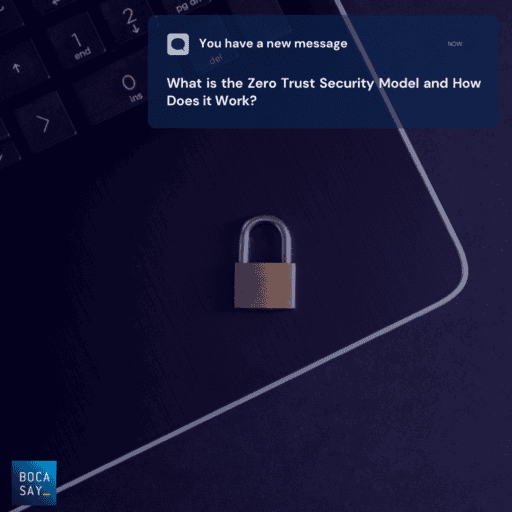What is the Zero Trust Security Model and How Does it Work?
In a world of growing cyber threats, adversaries, and careless or malicious insiders, the Zero Trust model of cybersecurity is an attractive proposition. While not perfect, the Zero Trust model offers a range of great benefits for enterprises. Moreover, moving from one cybersecurity strategy to another is neither quick nor easy. This is especially true for large organizations or those with outdated security systems.
Moving to a Zero Trust model may seem tempting, even mandatory, but leaders must also consider the disruption that accompanies such a transition.
To make Zero Trust cybersecurity as effective as possible, you must first understand its basic principles. In this article, our offshore outsourcing company, Bocasay, showcases the principles of the Zero Trust security model.

What is Zero Trust Security?
Zero Trust Security is a model of IT security that requires rigorous identity verification for all people and devices attempting to access the resources of a private network – whether inside ,or outside the network perimeter.
ZTNA is a key technology associated with Zero Trust architectures. However, it is a holistic approach to network security and includes several different principles and technologies.
Simply put, traditional computer network security trusts everyone and everything on the network. A Zero Trust security architecture trusts no one.
Traditional computer network security was based on the “castle and tower” concept. This type of security model makes it difficult to access the network from the outside, but by default, everyone within the network is always trusted.
How does Zero Trust Security work?
Continuous execution of this model can help organizations speed up the approval process for secure connections. This model essentially gives the right people the right access to the right data under the right conditions.
Here are the four Zero Trust principles that together form a governance model for sharing context among security tools in order to protect user connections, data and resources.
ℍ𝕠𝕨 𝕨𝕖𝕝𝕝 𝕚𝕤 𝕪𝕠𝕦𝕣 𝕔𝕠𝕞𝕡𝕒𝕟𝕪 𝕡𝕣𝕠𝕥𝕖𝕔𝕥𝕖𝕕 𝕒𝕘𝕒𝕚𝕟𝕤𝕥 𝕔𝕪𝕓𝕖𝕣𝕒𝕥𝕥𝕒𝕔𝕜𝕤? ℍ𝕠𝕨 𝕘𝕠𝕠𝕕 𝕚𝕤 𝕪𝕠𝕦𝕣 𝕔𝕪𝕓𝕖𝕣𝕤𝕖𝕔𝕦𝕣𝕚𝕥𝕪? 𝕋𝕠 𝕗𝕚𝕟𝕕 𝕠𝕦𝕥, 𝕔𝕒𝕝𝕝 𝕠𝕟 𝕥𝕙𝕖 𝕠𝕗𝕗𝕤𝕙𝕠𝕣𝕖 𝕠𝕦𝕥𝕤𝕠𝕦𝕣𝕔𝕚𝕟𝕘 𝕔𝕠𝕞𝕡𝕒𝕟𝕪 𝔹𝕠𝕔𝕒𝕤𝕒𝕪 𝕥𝕠 𝕡𝕖𝕣𝕗𝕠𝕣𝕞 𝕒 ℙ𝕖𝕟𝕥𝕖𝕤𝕥. 𝕋𝕙𝕚𝕤 𝕡𝕣𝕒𝕔𝕥𝕚𝕔𝕖 𝕒𝕚𝕞𝕤 𝕥𝕠 𝕥𝕖𝕤𝕥 𝕥𝕙𝕖 𝕡𝕣𝕠𝕥𝕖𝕔𝕥𝕚𝕠𝕟 𝕠𝕗 𝕪𝕠𝕦𝕣 𝕕𝕒𝕥𝕒 𝕒𝕟𝕕 𝕕𝕖𝕥𝕖𝕔𝕥 𝕥𝕙𝕖 𝕨𝕖𝕒𝕜𝕟𝕖𝕤𝕤𝕖𝕤 𝕠𝕗 𝕪𝕠𝕦𝕣 𝕔𝕪𝕓𝕖𝕣𝕤𝕖𝕔𝕦𝕣𝕚𝕥𝕪. ℝ𝕖𝕢𝕦𝕖𝕤𝕥 𝕪𝕠𝕦𝕣 𝕗𝕣𝕖𝕖 𝕢𝕦𝕠𝕥𝕖 𝕟𝕠𝕨!
Principle #1 – Define the context
You need to understand your users, data, and assets in order to establish security policies that are tailored to the particular needs of your business.
This process involves:
- The identification and classification of resources based on risk.
- Setting clear limits on resources.
- Segregating users based on role and function.
Principle #2 – Verify and Enforce
You will be able to protect your organization by validating the context and enforcing policies quickly and consistently.
This step requires active monitoring and validation of all access requests against the conditions defined in company policies. This will allow you to quickly and consistently grant the appropriate access to the appropriate resources.
Principle #3 – Incident Resolution
The Zero Trust model allows you to identify security breaches with minimal impact on the business, precisely by taking targeted actions. This work requires the preparation and execution of targeted actions such as:
- Revoking access for individual users or devices.
- Adjusting network segmentation.
- Quarantining users.
- Deleting devices.
- The creation of an incident ticket or the generation of compliance reports.
Principle #4 – Analyze and Improve
Continually improve your security pposition by adjusting policies and practices to make faster and better-informed decisions. This requires continuous evaluation and adjustment of policies, authorization measures and remediation tactics in order to reinforce the boundaries of each asset.
Benefits of Zero Trust Security
Benefit #1 – Increased Visibility Across your Organization
As mentioned above, a zero-trust security approach assumes that no one can be trusted. This is why you should determine what your security strategy should cover based on the criticality of data and its associated risks.
A Zero Trust framework requires visibility into existing and current resources, and organizations must create solutions that can detect, integrate and monitor access to these resources.
Benefit #2 – Improved Data Protection
Once malware penetrates your firewall, it can quickly locate and extract customer data and intellectual property. This damages your reputation and erodes your competitive advantage.
Restricting user access and the duration of that access can go a long way toward reducing the impact of a data breach. When access is restricted, cyberattackers are much less likely to find the data they seek.

Benefit #3 – Simplified IT Management
Because Zero Trust relies on continuous monitoring and analysis, you can use automation to evaluate access requests. Access is granted automatically if the Privileged Access Management (PAM)* system determines that the key credentials of the request are low risk. You do not have to approve every request. Only if it is flagged as suspicious by the automated systems.
The more securely a company automates tasks, the less staff is needed and the more time your team can actually spend on innovation and manual management of your core focus business activities.
*PAM : Privileged Access Management
Benefit #4 – Leverage of Existing Security Staff
A Zero Trust approach also helps security teams work smarter. Centralized monitoring means you can generate and store reliable data in one place, enabling robust analytics and providing new insights that help your team maintain a more secure environment.
Benefit #5 – Protect your Remote Teams
When users are spread around the world and data is dispersed on clouds, firewalls are no longer enough. Within a Zero Trust security approach, a user’s identity serves as the ‘border’ to the system.
Identity is attached to the users, devices and applications that seek to access the network, providing powerful protection for workers and data wherever they are.
The Drawbacks of Zero Trust Security
While the Zero Trust security model has become an increasingly popular approach to cybersecurity, is it still the most appropriate for your business? Here are some major drawbacks that you should not overlook:
- Requires significant time and effort to set up.
- Increased management of diverse users.
- More devices to manage.
- More complicated application management.
- More rigorous data security.
The Zero Trust cybersecurity model gives you a more secure network. If your company is the victim of a cyberattack, the virus cannot move laterally through the network because that movement is also regulated. So this comprehensive and specific approach is a good idea in terms of security. Ultimately, the success of a Zero Trust model depends on whether and how your company is able to implement it.